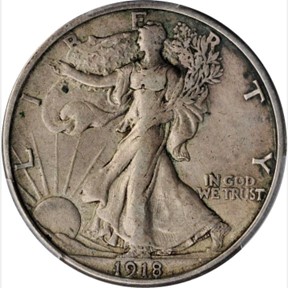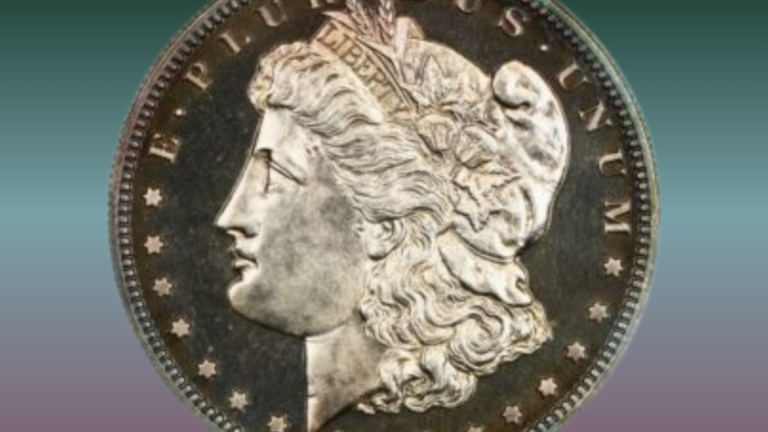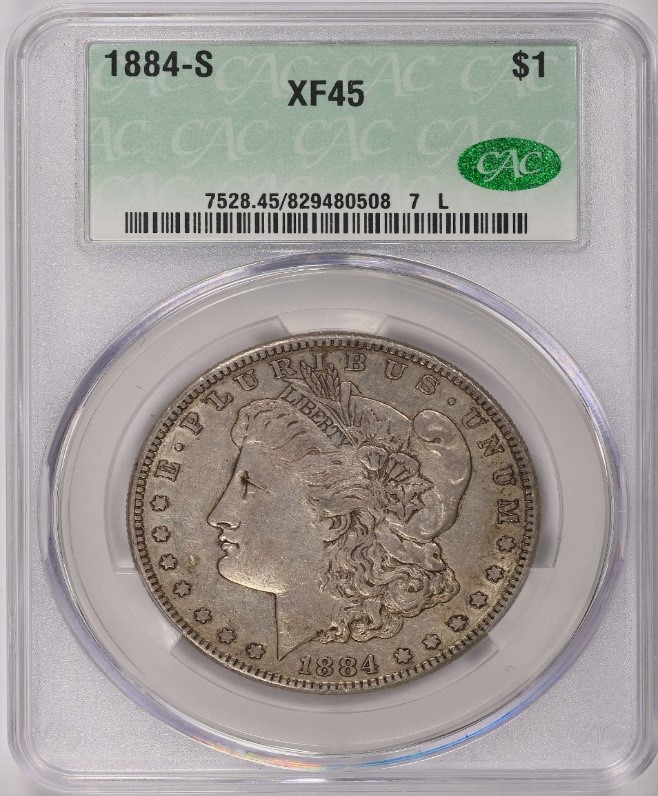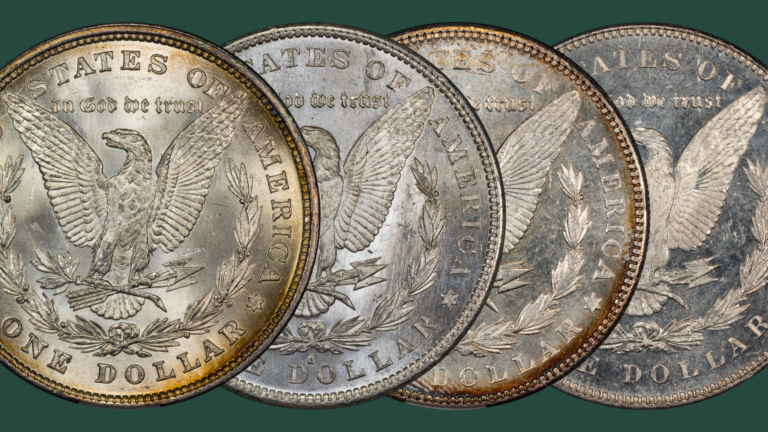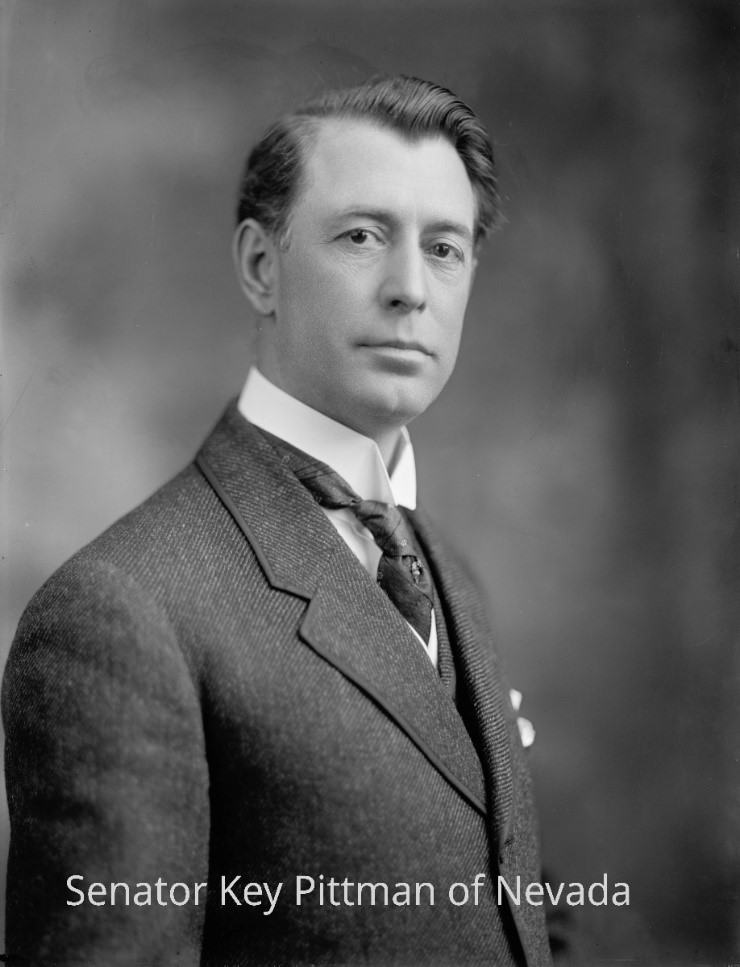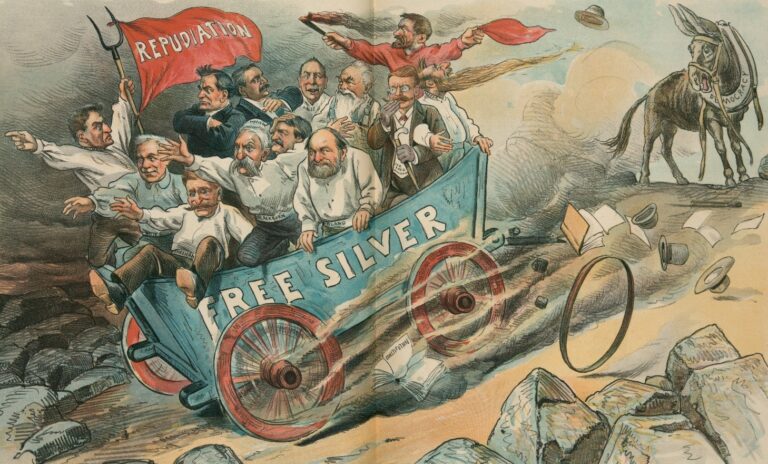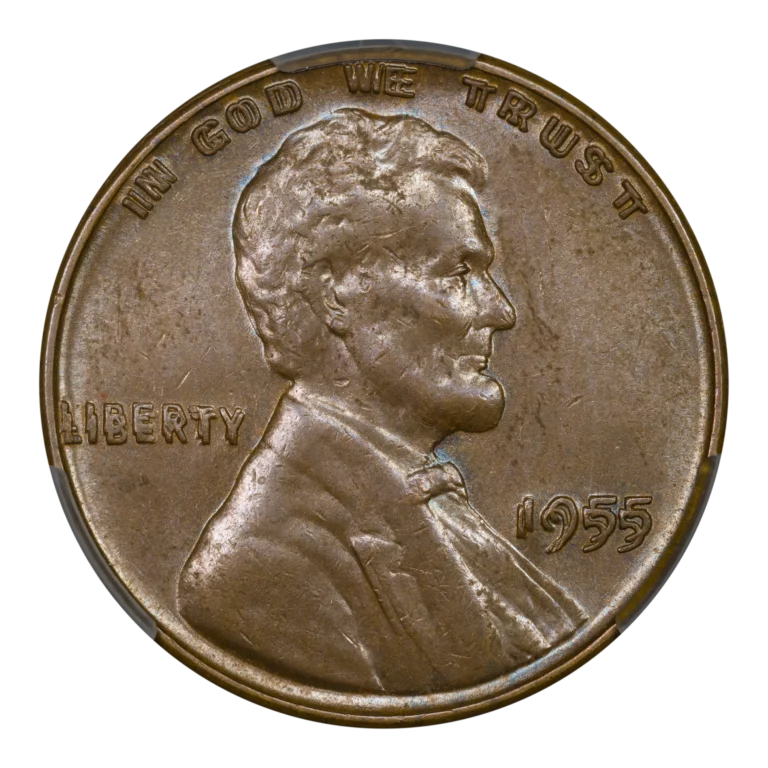by Greg Reynolds
This discussion is about assembling a type set of classic U.S. half dollars in Very Fine (VF) to Almost Uncirculated (AU) grades. Here, Liberty Seated halves dating after 1865, Barber halves (1892-1915) and Walking Liberty half dollars (1916-47) are covered. This is part of a series of collecting guides regarding classic U.S. coins, not modern or contemporary coins.
A Guide for Collecting a Half Dollars ‘Type Set’
While building a type set of half dollars, there are good reasons to ‘work backwards’ rather than start by collecting Flowing Hair half dollars (1794-95). Coins of later types tend to be less expensive and easier to acquire. It is a good idea for a collector to learn about the subject matter and to gain some experience before deciding whether to spend an amount that he or she regards as ‘a lot of money’ on a particular collecting project. Collectors tend to learn while they are collecting.
In this group of discussions overall, there are separate guides for collecting choice quality and gem quality, classic U.S. half dollars by design type. A decision as to whether to collect circulated coins, choice uncirculated coins, gem quality coins, or Proofs, depends upon the preferences and budget of each individual collector.
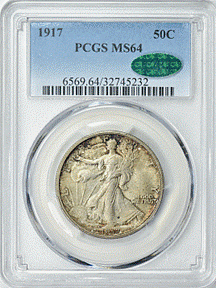
There is not a simple plan for everyone. As I have been enthusiastic about classic U.S. coins since I was five years old, have carefully viewed more than 50,000 coin auction lots, have been an expert consultant for many years, and have written more than seven hundred published articles relating to coins, I feel comfortable providing information and putting forth advice. I focus on classic U.S. coins, and I hope to generate more enthusiasm for them.
Classic U.S. coins, generally, are of series that began well before 1934. Of course, series that began before 1934 did not all finish by 1934. The main distinction between classic U.S. coins and modern U.S. coins is that 1933/34 or so, with a few exceptions, is a dividing line. For any given denomination, U.S. coins minted after 1934 tend to be dramatically more common than coins of the same denomination minted before 1934. I am a believer in collecting coins that are at least somewhat scarce rather than those that are extremely common.
Lincoln cents that date from 1933 onward are dramatically more common than Lincolns that date before 1933 or so. The same is true of Mercury dimes and Walkers. Of course, there are exceptions to the rule. The 1938-D Walker is relatively scarce. U.S. Mint Errors from all time periods tend to be rare.
Also, regular issue U.S. gold coins were last minted in 1933. U.S. gold pieces minted since the 1980s are modern issues and constitute a subject that is much different from classic U.S. gold coins.
Thirteen Types of Classic U.S. Half Dollars
There are thirteen types of classic U.S. half dollars: 1) Flowing Hair (1794-95); 2) Draped Bust, Small Eagle (1796-97) ; 3) Draped Bust, Heraldic Eagle (1801-07); 4) Reich Capped Bust, ‘Lettered Edge’ (1807-36); 5) Gobrecht Capped Bust, ‘Reeded Edge’ (1836-39); 6) Liberty Seated, No Drapery, No Motto (1839 only); 7) Liberty Seated, With Drapery, No Motto (1839-53, 1856-66); 8) Liberty Seated, Arrows & Rays (1853 only); 9) Liberty Seated, No Motto, With Arrows, No Rays (1854-55); 10) Liberty Seated, With Motto (1866-91 except 1874); 11) Liberty Seated, With Motto, With Arrows (1873-74); 12) Barber (1892-1915); 13) Walking Liberty (1916-47).
All U.S. half dollars dating from 1837 until 1964 were specified to be 90% silver. From 1794 to 1836, U.S. silver coins were specified to be 89.24% silver (“1485/1664”). During January 1837, there was formally established an official standard of 90% silver (‘900 Fine’) and 10% copper.
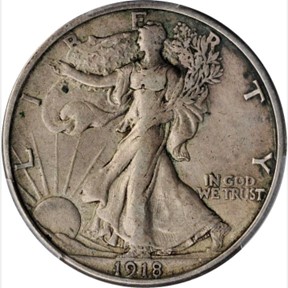
Although Walking Liberty half dollars dating from 1935 to 1947 could fairly be called classic U.S. coins, these are extremely common, except the 1938-D, and are just too easy to find. It would not be fun to acquire one Walker from the 1940s.
A type set would be more meaningful if it did not contain any extremely common coins. The 1929-D is a somewhat ‘better date,’ which means that is not nearly as common as common dates. On January 13, 2021, Heritage sold a PCGS graded XF-40 1929-D Walking Liberty half dollar for $99.
Because they are not particularly valuable, circulated 1929-D Walkers are not often sent to CAC, though some were submitted. On January 26, 2020, the firm of David Lawrence sold a CAC approved, PCGS graded Fine-15 1929-D for $43.
Early Date Walking Liberty Half Dollars
For a type set, it is practical to find and select one modestly priced ‘early date’ Walker. In December 2020, Heritage sold a CAC approved, PCGS graded XF-45 1918 for $192.
An early date Walker that costs much less than most of the others is the 1918-S. On March 24, 2020, Stack’s-Bowers auctioned a PCGS graded XF-40 1918-S for $70. On April 11, 2021, the firm of David Lawrence sold a CAC approved, AU-50 grade 1918-S for $240.
Though not especially scarce, the 1920-S is certainly not a ‘common date.’ In March 2018, Heritage sold a CAC approved VF-30 grade 1920-S Walker for $132. The 1920-D is scarcer. In February 2019, Heritage sold a CAC approved, PCGS graded VF-25 1920-D for $288.
In the grand scheme of classic U.S. silver coins, CAC approved, circulated ‘early date’ Walkers are not particularly expensive, though are not easy to find. It is fun to search for early Walkers that are fairly graded, reasonably priced and particularly appealing.

Type #12 – Barber Half Dollars (1892-1915)
Barber Half dollars are extremely similar to Barber quarters and somewhat similar to Barber dimes (1892-1916). Charles Barber also designed Liberty Head nickels (1883-1913). Additionally, he is credited with designing one or both sides of several commemorative coins and a few medals.
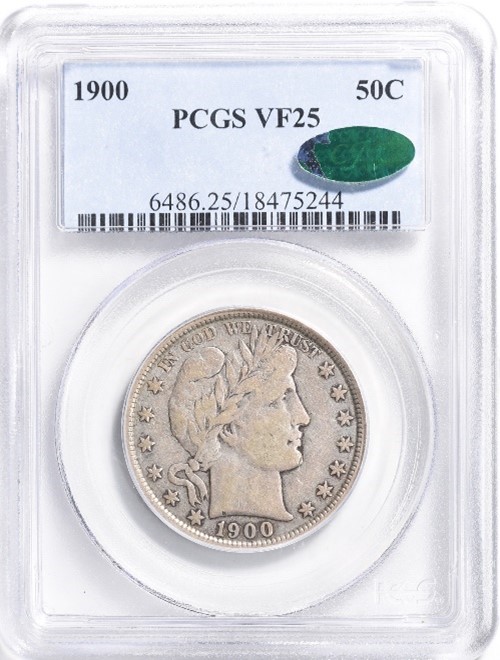
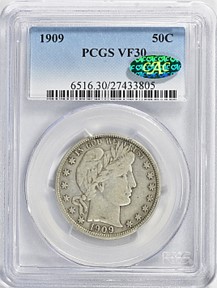
For modest prices, circulated Barber halves of many dates in a wide range of grades are often available. On February 14, 2021, the firm called GreatCollections sold a PCGS graded VF-25 1915-S Barber half for $134.44.
On average, circulated Barber halves with CAC stickers will be relatively more original and less likely to have technical issues that are bothersome. GreatCollections sold a CAC approved XF-40 grade 1908-D for $190.12 on May 30, 2021 and a CAC approved VF-30 grade 1909 for $185.62 on July 11, 2021. On December 6, 2020, the firm of David Lawrence sold a CAC approved, NGC graded AU-58 1899 half for $425.
There are a large number of VF-20 to AU-50 grade Barber halves available. Not many of these, however, have been CAC approved. It is also true that most VF to XF grade Barber halves have not been submitted to CAC.
Type #11 – Liberty Seated, With Motto, With Arrows (1873-74)
Liberty Seated half dollars were minted from 1839 to 1891, and there are multiple design types. This ‘With Arrows’ type was minted during just two years, 1873 and 1874. The previous ‘With Motto – No Arrows’ type was resumed in the middle of 1874 and continued until 1891.
In 1873, there was a slight change in the weight standard for silver coins, and emphasis was placed on the metric system at the U.S. Mint, though these were not the only reasons for the arrows. The arrows on silver coins of 1873 and 1874 are far more historically important than most collectors realize. Arrows were added to the obverse design that was employed in 1873 and 1874 to draw attention to the Coinage Act of 1873, which was sweeping, not widely understood and represented a path breaking shift in U.S. Treasury Department policies.
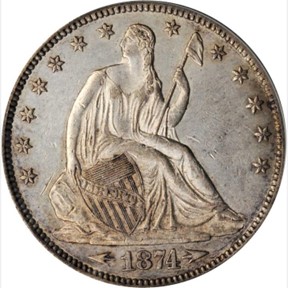
‘With Arrows’ silver coins now represent an important part of U.S. monetary history. For a small amount of money, an appealing and naturally toned 1873 or 1874 half may be acquired for a type set.
On June 16, 2019, GreatCollections sold a CAC approved, PCGS graded AU-50 1874 ‘With Arrows’ half for $388.12. In November 2019, Stack’s-Bowers auctioned a CAC approved, PCGS graded AU-53 1874 for $384.
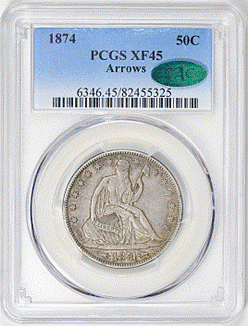
CAC approved coins of this design type are scarce. As of Sept. 8, 2021, CAC has approved fifty 1873 ‘With Arrows’ business strike halves, though just twenty-two of these grade below AU-58. Of the 1874 ‘With Arrows’ issue, CAC has approved fifty-nine business strikes, thirty-one of which grade below AU-58. Nevertheless, they can be found and only one is needed for a type set. Besides, many circulated Liberty Seated halves have never been sent to CAC. A significant number of those would qualify if submitted.

Show off Your Collection in the CAC Registry!
Have CAC coins of your own? If so, check out the CAC Registry–the free online platform to track your coin inventory, showcase your coins by building public sets, and compete with like-minded collectors!
Type #10 – Liberty Seated, With Motto (1866-91 except 1874)
In 1866, the motto, ‘In God We Trust,’ was added to the reverse design. Half dollars were otherwise the same as they were during the latter part of the 1850s until 1865, except that half dollars of this type minted from 1874 to 1891 were required to conform to the weight standard established by the Coinage Act of 1873, 12.5 grams, not to the 1853 standard, 192 grains (= 12.44 grams).
Even in the 1870s, a period during which members of the general public were particularly concerned about the market values of silver and gold, few people cared about the distinction between 12.5 grams (192.9045 grains) and 192 grains (12.44 grams), a difference of 0.06 gram, less than than one grain. One Troy ounce equals 480 grains.
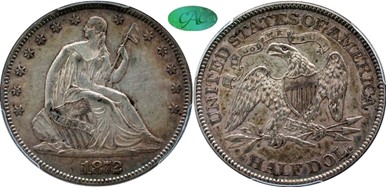
A lesser objective of the Coinage Act of 1873 was to push the metric system. Few U.S. citizens were interested in the metric system at the time. Even now, most U.S. citizens are content with the Anglo-American system of weights and measures, with inches, feet, yards, miles, teaspoons, ounces, pounds, gallons, etc.
Policy issues are beside the point that circulated half dollars of the ‘With Motto’ type are abundant in the present. As other coins in a type set of classic U.S. half dollars will cost far more than a low grade half of this type, it makes sense to acquire a very appealing half of this type, perhaps of a better date. These can be purchased for modest prices.
A CAC approved, NGC graded XF-40 1875 half was auctioned for $258.50 in a sale of coins from the Eric Newman Collection by Heritage in November 2013. The same coin was sold by GFRC in August 2016 for $180. Apparently, it remained in its original NGC holder with the special Eric Newman Collection label.
In April 2020, Gerry Fortin (GFRC) sold a CAC approved, PCGS graded AU-50 1876 half dollar for $295. On February 23, 2020, GreatCollections sold a CAC approved, PCGS graded AU-50 1876-S half dollar for $281.25. In January 2021, GFRC sold CAC approved AU-53 grade 1872 half dollar for $639.
For under $300, a CAC approved Extremely Fine to AU grade half dollar of this type may be acquired, though some patience may be required. For under $500, a really pleasant XF grade representative of one of the better dates could be purchased without much difficulty.
In the next part, it will be explained that many half dollars minted before the U.S. Civil War (1861-65) are modestly priced too. Representatives of very early types of half dollars, however, are considerably more expensive. A complete type set is fun and a little challenging to build.
Images are copyrighted by Gerry Fortin, Great Collections, and Stack’s Bowers.
Copyright © 2021 Greg Reynolds
About the Author
Greg is a professional numismatist and researcher, having written more than 775 articles published in ten different publications relating to coins, patterns, and medals. He has won awards for analyses, interpretation of rarity, historical research, and critiques. In 2002 and again in 2023, Reynolds was the sole winner of the Numismatic Literary Guild (NLG) award for “Best All-Around Portfolio”.
Greg has carefully examined thousands of truly rare and conditionally rare classic U.S. coins, including a majority of the most famous rarities. He is also an expert in British coins. He is available for private consultations.
Email: Insightful10@gmail.com
